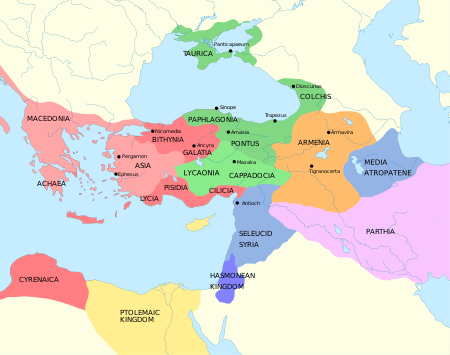Asiatic Vespers
The Asiatic Vespers (also known as the Asian Vespers, Ephesian Vespers, or the Vespers of 88 BC) refers to an infamous episode prior to the First Mithridatic War, serving as the casus belli, or immediate cause of the war.

Background
Rome had been asked to arbitrate long-standing disputes between the Kingdom of Bithynia and the Kingdom of Pontus, which were located side by side on the south shore of the Black Sea. The ruling families of each had descended from Persian satrapies unincorporated into the empire of Alexander the Great. Roman troops had been drawn into Anatolia as allies of the Republic of Rhodes, which had holdings there. Now that they were there, the two kings decided to ask the Roman Senate to settle their dispute.
The Senate's choice
After deliberation the Senate decided to back Bithynia. The king of Pontus, Mithridates VI, hitherto a friend of Rome, whose ancestors had sent ships to help it in the Third Punic War, was willing to accept this decision. The Senate's control over its troops in the field, however, was minimal. At the instigation of the soldiers, the Roman officers in Anatolia began to urge the Bithynians to ravage Pontus, falsely claiming the decree of the Senate had created an armed conflict. The Senate had actually instructed the army that, in the event of war between Bithynia and Pontus, they were to assist the Bithynian army . In that capacity they would have a share in the spoils of war accrued from plundering the rich towns of Anatolia.
Mithridates's massacre of Roman citizens
Eager to please their Roman advisors, the Bithynians began to ravage Pontus assisted by Roman soldiers of mercenary intent. In vain Mithridates attempted to object through diplomatic channels. Despairing of that course of action he turned to his friends and allies in Anatolia, convincing their uncertainty through gifts and promises. He would rid them of the Romans with a single blow. He convinced them to orchestrate the assassination of all Roman and Italian citizens in Asia Minor (Anatolia).[1] The massacre was planned scrupulously to take place on the same day in several towns scattered over Asia Minor: Ephesus, Pergamon, Adramyttion, Caunus, Tralles, Nysa, and the island of Chios.[2]
Estimates of the number of men, women, and children killed range from 80,000[3] to 150,000.[4] Slaves who helped to kill their Roman masters and those who spoke languages other than Latin were spared. Although successful for the short term, the blow fell short of ridding Anatolia of Romans. All who could fled across the Aegean to seek refuge in the port of Rhodes, firm allies of Rome, and henceforward to be deadly enemies of Mithridates. When word of the massacre reached Rome, the mood of the people turned to outrage. The Senate in special session declared war on Mithridates, formulating a mandate to be given to the consuls of the year.
The Romans' response
The declaration was immediate, but implementation of the mandate was delayed by civil war at Rome. Sulla received it first from the Senate. After Sulla had taken command of the legions at Nola, a Roman Assembly passed a law stripping him of his authority in favor of Gaius Marius. At the instigation of his men he marched on Rome to assert the authority of the Senate. Assured of its and his authority he crossed the Adriatic with minimal troops and no heavy warships, after one year of doing nothing on the eastern front.. Meanwhile, Mithridates had created a large fleet that scoured the Aegean of Romans. He subverted the city of Athens, making use of his partisans there, including the peripatetic philosophers. He could not, however, despite maximum effort, take the port of Rhodes, as the Rhodians were master mariners, on whose ships the Romans had redesigned their own. When Sulla's men finally arrived to conduct a siege of Athens, all mainland Greece had rallied to the Roman cause. A series of conflicts known as the Mithridatic Wars followed.[5]
Dating of the massacre
The date of the massacre is disputed by modern historians who have written about the question at length. Sherwin-White places the event in late 89 or early 88 BC.[6] Badian, saying "precision seems impossible," places it in the first half of 88 BC, no later than the middle of that year.[7] The name "Vèpres éphésiennes" was coined in 1890 by historian Théodore Reinach to describe the massacre, making a retrospective analogy with the Sicilian Vespers of 1282.[8] Subsequent historians have adopted some variation of the phrase, using Vespers as a euphemism for "massacre".
Notes
- "Appian, The Mithridatic Wars 5.22". www.livius.org. Retrieved 2019-06-18.
- Orosius, 6.2.2-3; Eutropius, 5.5.2.
- Valerius Maximus 9.2.3; Memnon 22.9.
- Plutarch, 24.4.
- Mayor, pp.13-24.
- Sherwin-White, pp. 1981-1995.
- Badian, pp. 105-28.
- Reinach, p. 131.
References
- Appian, Mithridatic Wars.
- Badian, Ernst, 1976. "Rome, Athens and Mithridates," American Journal of Ancient History 1.
- Eutropius, Abridgement of Roman History.
- Mayor, Adrienne, 2010. The Poison King: The Life and Legend of Mithradates, Rome's Deadliest Enemy, Princeton and Oxford: Princeton University Press.
- Memnon, History of Heraclea.
- Orosius, Seven Books of History Against the Pagans.
- Plutarch, Life of Sulla.
- Reinach, Théodore, 1890. Mithridate Eupator, roi de Pont, Paris: Firmin-Didot.
- Sherwin-White, A.N., 1980. "The Opening of the Mithridatic War," Miscellanea di studi classici in onore di Eugenio Manni, ed. M.J. Fontana, M.T. Piraino, F.P. Rizzo, vol. VI, Rome.
- Valerius Maximus, Memorable Deeds and Sayings.
Further reading
- Mayor, Adrienne, 2010. The Poison King: The Life and Legend of Mithradates, Rome's Deadliest Enemy, Princeton and Oxford: Princeton University Press. ISBN 978-0-691-12683-8